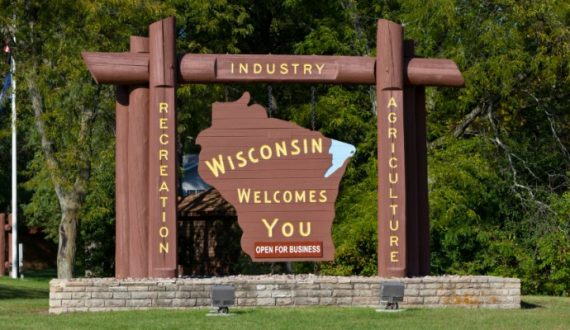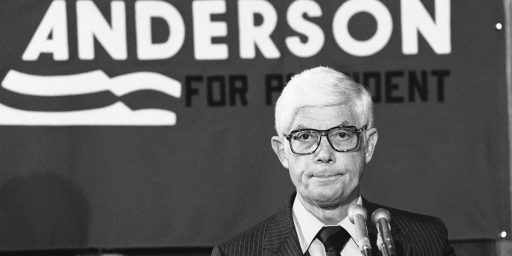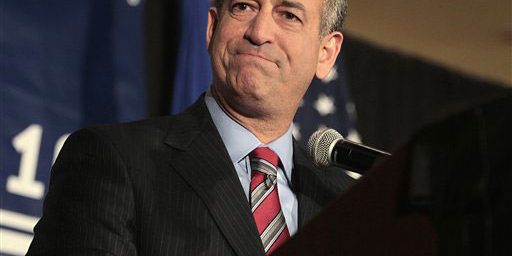Wisconsin Unlikely To Go Republican In 2016
Republican hopes that Wisconsin might go Republican this year seem to be slipping away.
Wisconsin has not gone for a Republican in a Presidential election since Ronald Reagan defeated Walter Mondale in thirty-two years ago, and if the latest Marquette University Law School poll is any indication, it’s not going to happen this year either:
MILWAUKEE – A new Marquette Law School Poll finds Democratic candidate Hillary Clinton with support from 46 percent of Wisconsin registered voters and Republican candidate Donald Trump with support from 36 percent in a head-to-head presidential matchup. Sixteen percent say they will vote for neither candidate, will not vote, or don’t know how they will vote.
In the most recent Marquette Law School Poll, in July, Clinton had 43 percent support and Trump 37 percent, with 18 percent saying they would vote for neither, would not vote or didn’t know.
Among likely voters, i.e., those who say they are certain they will vote in November, Clinton is supported by 52 percent and Trump by 37 percent in the new poll, with 10 percent saying they will support neither candidate. In July, likely voters gave Clinton 45 percent support, Trump 41 percent and 14 percent said they would vote for neither.
In a four-way matchup including Clinton, Trump, Libertarian candidate Gary Johnson and Green Party candidate Jill Stein, Clinton is supported by 42 percent of registered voters, with Trump at 33 percent, Johnson at 10 and Stein at 4. A total of 11 percent in that matchup say they will vote for none of the candidates, won’t vote or don’t know how they will vote. Among likely voters, Clinton receives 47 percent, Trump 34, Johnson 9 and Stein 3. In July’s four-candidate question among registered voters, Clinton received 40 percent, Trump 33, Johnson 10 and Stein 4. Among likely voters in that poll, Clinton received 43 percent, Trump 37, Johnson 8 and Stein 2 percent.
Not unlike Pennsylvania, Wisconsin is a state that seemingly comes up every four years as one of those states that some Republicans seem to think they can make a breakthrough in where those before them have failed miserably. Most recently, the electoral success of Governor Scott Walker, who handily won three statewide elections in three years, and Paul Ryan has led many Republicans to believe that this traditionally blue state would finally go for a Republican. This year, that argument has gotten renewed attention given the fact that the Trump campaign’s seemingly narrow path to Electoral College victory depends upon winning states in the industrial Midwest since he is seemingly becoming less competitive by the day in states such as Virginia, Colorado, and Nevada. This Marquette poll, though, which is both among the most widely respected in the Badger State and the first to be conducted since the two party conventions, suggests quite strongly that Republicans would do best to keep their hopes to a minimum when it comes to winning this state. Compared to the last Marquette poll conducted in early July, Clinton’s numbers in a head to head match-up have increased from 45% to 52% while Trump’s have dropped from 41% to 37%. In a four-way race that includes Gary Johnson and Jill Stein, Clinton’s numbers increased from 43% to 47%, Trump’s dropped from 41% to 37% to 34%, Johnson saw his numbers increase from 8% to 9%, and Stein saw hers increase from 2% to 3%. In looking at these numbers, it’s worth remembering that Trump lost the Badger State by nearly 150,000 votes back in April, so there obviously isn’t a lot of love for Trump there. Additionally, the fact that he has, at best, tepid support from Wisconsin politicians such as Walker and Ryan is no doubt impacting Republican enthusiasm for Trump’s candidacy.
The RealClearPolitics average for a head to head match-up gives Clinton a 9. 4 point lead, and a 9.0 point lead in a four-way race. In the Pollster average, Clinton has an 11.2 point lead, and Nate Silver currently gives Clinton a roughly 86.5% chance of winning the Badger State in November. Unless the numbers change here significantly, Trump’s plan for a Midwestern path to victory seem doomed.
Things also aren’t looking good for Republicans in the battle to hold on to the Senate seat that Ron Johnson won in 2010:
In a head-to-head matchup for Wisconsin’s U.S. Senate race, among registered voters, Democratic candidate Russ Feingold is supported by 49 percent while Republican incumbent Ron Johnson receives 43 percent. In July, Feingold had 48 percent support and Johnson 41 percent.
Among likely voters in November’s election, Feingold has the support of 53 percent while Johnson is supported by 42 percent. Among likely voters in July, Feingold was supported by 49 percent and Johnson by 44 percent.
When Libertarian candidate Phil Anderson is included in the Senate contest, among registered voters, Feingold receives 47 percent, Johnson 38 percent and Anderson 7 percent. Among likely voters, it is Feingold 50 percent, Johnson 39 percent and Anderson 7 percent.
For registered voters in the July poll, Feingold received 45 percent, Johnson 38 percent and Anderson 8 percent. Among likely voters, Feingold received 46 percent, Johnson 40 percent and Anderson 7 percent.
The numbers here aren’t entirely surprising given the fact that Feingold remained a popular figure in Wisconsin politics notwithstanding his loss to Johnson in 2010 to the extent that he was recruited, unsuccessfully, to challenge Scott Walker for Governor in both the recall election in 2012 and Walker’s run for re-election in 2014. Feingold declined both times and seemed to suggest that his time on the electoral stage was over, but the truth seems to be that he was more interested in mounting a bid to get his Senate seat back. All signs seem to indicate that he will succeed. To date, there hasn’t been a major poll in the state that hasn’t shown him leading Johnson, usually by a significant margin and he presently has an 11.3 point lead in the RealClearPolitics average and an 8.8 point lead in the Pollster average. Absent a significant change, this would appear to be a seat that the GOP is likely to lose in November.







In ’96, the GOP knew Dole was doomed and turned its attention to the down-ballot races with a large number of Congress-critters arguing that voters needed to elect them as a check on Clinton. Somewhat surprising we haven’t seen that messaging yet given the clear polling trends.
@SKI: I think they may have painted themselves into a corner here. You can’t spend years convincing your base that someone is literally the devil, then not pull out all the stops opposing her the last three months of an election. Even the dim bulbs who support Trump would see through that one.
Wisconsin: Scott Walker, Paul Ryan, Glenn Grothman, Ron Johnson just to name a few. I guess the state is Madison, Milwaukee, and everywhere else.
Johnson and Grothmann are just out to lunch, and Governor Walker has taken it upon himself lead state Republican efforts to curb collective bargaining by public employee unions (except for public safety staff), cut education funding at every level, and (as in Louisiana and Kansas) the state economy is lagging.
Wisconsin: A blue state every 4 years and a red state every mid-term election.
@al-Alameda:
There’s the large city of Milwaukee, the Peoples Republic of Madison, and otherwise it’s cheese head hillbillies. Pretty much like most states. I have a friend who lives in the crescent of suburbs to the north and west of Milwaukee that has been called the most conservative/Republican area in the country.
“Failed miserably” is a bit of an exaggeration. Bush twice came within less than a half of a percentage point of winning Wisconsin. It has since moved strongly in a Democratic direction, and certainly with Trump’s national numbers as bad as they are, it’s not surprising his numbers in Wisconsin don’t look too promising. But in the Bush era at least, it wasn’t unreasonable to classify it as a purple state. These things are not set in stone.
@Surreal American:
Exactly correct. The Democrats can’t seem to get their people to give a damn in the mid-terms. Bush did get really close in 2000 and 2004 to flipping this one, and a rational GOP candidate would probably have made this state quite a slugfest. But, it’s not. And won’t be.
It’s an interesting state. Probably center-left generally, but the 2010 dominance by the GOP led to what is perhaps the most slanted gerrymander in the country. It’d have to be a huge Democratic wave to loosen the GOP stranglehold on the statehouses. I think in the 2014 midterm the Democrats got more votes, and the GOP took like 2/3 of the seats. A center-left state with a hard right-wing representation. It’s been interesting, to say the least.
@SKI: There is little reason to believe that this worked in 1996. The Democrats won two seats in the House and all the Republican gains in the Senate were in Republican leaning states(You could argue that most of these wins were due to the natural realignment in the South).
Distancing yourself from the President of your own party NEVER works, I doubt that distancing yourself from your nominee works.
@Andre Kenji:
Fervently hope you are right on this, and hope we may see an anti Trump wave. Nothing much in the polling yet.
@Andre Kenji: you may be right but…
And the quote itself:
This is Steven King, mind you. Yeah, the insane batshit crazy one from Iowa…
@SKI: Remember this ad?
https://www.youtube.com/watch?v=doe_nTBQ4MY
It did not work. I don´t know if it´ll work for Steven King.
@Cory:
I don’t think that’s the main story here.
Part of it is that people (correctly) feel like they can make more difference by electing a President with veto power and SCOTUS nomination rights than by electing 1/50 of the Senate, or 1/435 of the House. Lobbying interests, on the other hand, are very aware of how much profit is to be had from purchasing the kind attentions of the Senator or Representative for their State or District.
Part of it is that the extreme partisan intransigence of the GOP in Congress is a relatively new thing; in the past the President (of either party) had much more ability to negotiate for legislation that the minority party in Congress would never have proposed.
Part of it is also the gerrymandering you referred to later in your post. There just aren’t that many Congressional districts in the US that are more competitive than, say, Oklahoma or the District of Columbia in a Presidential election.
Part of it is that there is no Democratic media Mecca where a large fraction of the potential voters routinely get their indoctrination, and could be reminded of the importance of Senate and House elections. Fox News plays a vital role for the GOP in midterm elections. It’s not that the Dems can’t get their people to give a damn; it’s that they can’t even make contact with them in first place, outside of a Presidential election cycle.
@Cory:
In 2014, Republicans won 51% of the votes cast for House members, but won 57% of the seats, while Democrats won 46% of the votes but 43% of the seats.
Irrespective of why this happened, it should be clear that the GOP does not enjoy the degree of popularity among voters that is reflected in the number of seats.
That being said, Democrats tend to be more numerous but less loyal; accordingly, lower turnout generally favors the GOP. This was true even before the Southern Strategy realignment, so it is nothing new.